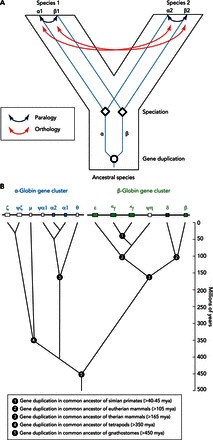FIGURE 1.

Phylogenetic reconstructions reveal the branching relationships among members of a multigene family that have diversified via successive rounds of duplication and divergence
A: paralogous genes trace their common ancestry to duplication events, whereas orthologous genes trace their common ancestry to speciation events. B: phylogenetic diversification of the α- and β-globin gene subfamilies. The human α- and β-globin gene clusters are shown at top. Pseudogenes are denoted by the Ψ symbol. In the human α-globin gene cluster, for example, Ψζ denotes an inactivated copy of the embryonic ζ-globin gene. The tree depicts phylogenetic relationships among the paralogous gene duplicates. The inferred timing of duplication events is indicated on the vertical axis. Note that the human μ-globin gene is orthologous to the αD-globin gene of other tetrapods, as discussed in the text.
